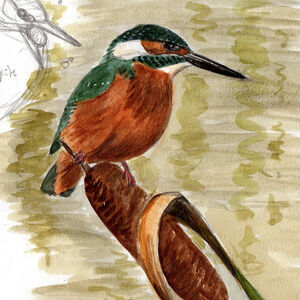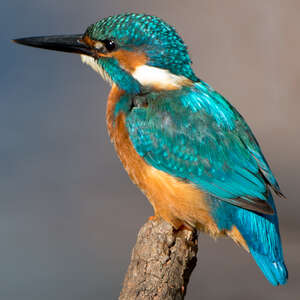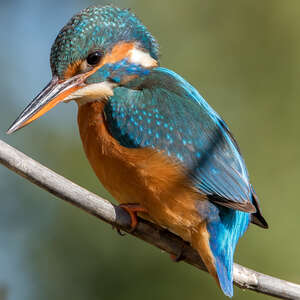Common Kingfisher
Alcedo atthis - Martin-pêcheur d'Europe
Identification
The Common Kingfisher is a small Old World alcedinid with blue and red plumage like many other members of its family, and the only one to have this coloration across most of its Eurasian range. Sexual dimorphism is weak, with the adult having an altogether bright blue upperparts from the mantle to the tail-coverts. The scapulars and the wing-coverts are darker, being greenish tinged with pale blue. The underparts are a vivid red, except for the white-to-cream throat. The head pattern is remarkable. The crown is-blue tinged green and heavily mottled. The blackish loral area contains a reddish spot. The eye is dark and the reddish ear-patch, edged with blue below, is diagnostic to the species. On the sides of the neck is an indistinct white collar. During the nuptial period, the dagger-shaped bill is black in adult male, black with the base of the lower mandible orange in adult female. The small, typical feet of the family are reddish-vermilion. The seven described subspecies show only subtle differences in size and color. The juvenile is overall duller, with the upperparts less blue and more green, and the underparts of a paler red, with the chest at first obscurely streaked with brown. The blackish bill has a whitish tip and the feet are rosy.
Subspecific information 7 subspecies
- Alcedo atthis atthis (s Spain and n Africa east to c Siberia, nw China and nw India)
- Alcedo atthis ispida (s Norway, the British Isles and n Spain to w Russia)
- Alcedo atthis bengalensis (c India to se Siberia, Japan and se Asia)
- Alcedo atthis taprobana (s India and Sri Lanka)
- Alcedo atthis floresiana (Lesser Sundas)
- Alcedo atthis hispidoides (Sulawesi, Moluccas, w Papuan islands, New Guinea, Bismarck Arch. and Louisiade Arch.)
- Alcedo atthis salomonensis (Solomon Is.)
Foreign names
- Martin-pêcheur d'Europe,
- Martín pescador común,
- guarda-rios-comum,
- Eisvogel,
- jégmadár,
- IJsvogel,
- Martin pescatore,
- kungsfiskare,
- Isfugl,
- rybárik riečny,
- ledňáček říční,
- Isfugl,
- kuningaskalastaja,
- blauet comú,
- Bláþyrill,
- zimorodek (zwyczajny),
- zivju dzenītis,
- vodomec,
- Зимородок,
- Raja-udang erasia,
- カワセミ,
- 普通翠鸟,
- นกกะเต็นน้อยธรรมดา,
- 普通翠鳥,
Voice song and call
The usual call of the Common Kingfisher, or at least the one that can be heard best and most frequently, is a sharp and emphatic siii somewhat reminiscent of a Common Hedge Sparrow's call, but much more powerful and repeated. This is the bird's call as it arrives with a blue streak over water. Its song consists of a succession of piercing, somewhat variable whistles. A high-pitched and vibrating tri tri tri tri tri... is used to assert itself against another of its kind or repel an intruder. The young endlessly beg at the nest with low-toned rolling cries.
Habitat
The Common Kingfisher frequents the banks of bodies of water whether they are stagnant or running. These can be very varied but they must be full of fish and small fish of their own size. The water must be clear enough for them to efficiently fish in. There also must be riverine vegetation for them to perch atop when looking for prey, although occasionally they can hover mid-air in search of prey. The environment can be natural or artificial. For example, the many gravel pits that result from extracting gravels, recolonised by vegetation and stocked with fish, constitute new territories for the kingfisher.
Behaviour character trait
You can hear the Common Kingfisher more than you can see it. It is generally by its piercing cry that we are alerted to its presence.
Most of the time, all we can see of the bird is a blue arrow darting quickly above the water's surface with all the power of its tiny vibrant wings. The blue color of its upper parts merges with the clear sky reflected by the water's surface. It is not easy to find it perched in the vegetation, still, despite its bright colors. On the other hand, when you know where it is located, all you have to do is wait to observe its fishing activity. It remains on a high lookout spot, with its head and tail shaking in nervuous motions. When a fish is spotted, it quickly leaves its perch in an oblique flight, rushes to the surface to seize the fish and returns to its perch. With its quick movements and its numerous calls, it suggests an aggressive bird, quick to defend its territory against intruders. It takes courage, when we know that in the best occupied areas, the density can reach 6 to 8 couples per kilometer of river. It cannot afford to let it go, it must defend its territory at all costs. When you know a nesting site, the observations are quite easy, provided you blend in with the environment, for example using camouflage netting, as the bird is shy.Flight
With its short, rounded wings beating at a high frequency, the Common Kingfisher's flight is very fast and direct, capable of travelling only in open areas, either over water or on solid ground.
It also has the ability to make brief stationary flights while fishing. Generally, its nesting site is clear enough to provide direct access to the nest; on the other hand, if it is by a riverside, a bit crowded with trees, the bird can reach its nest by climbing, step by step. Its wing structure also allows the Common Kingfisher to briefly swim underwater and use the water surface to take off after its dive. It is astonishing that the Common Kingfisher can be a migratory bird with such wings; its migration is never active at a high altitude, but rather slow and step by step.Dietfeeding habits
The main diet of the Common Kingfisher is made up of small fish of all kinds: minnows, gudgeon, roach and chub, trout, etc.
as long as their size does not exceed 125 mm. Fish make up at least 60% of the diet. The rest is made up of amphibians (small anurans or tadpoles), of large aquatic arthropods (dytids, dragonfly larvae, crustaceans, etc.) and, anecdotally, of some molluscs. The bird watches for its prey from a perch no more than three metres high, or it practices hovering. Once the prey is spotted, it usually dives from a rapid oblique flight and folds its wings backward at the moment of impacting the surface. It seizes the fish with its beak and with a powerful flap of its wing, it resurfaces almost instantly and returns to its perch. If the prey is small, it's swallowed head first. On the other hand, a large prey is grasped with the beak and stunned with great blows against the support, then swallowed lifeless. After digestion, the Common Kingfisher regurgitates the indigestible part of its prey (scales, bones) in the form of small white or grey pellets. The availability of free waters conditions the biology of the bird. It will be sedentary when this availability is annual. Otherwise, it will be migratory.Reproduction nesting
The breeding period varies according to location. In Europe it is typically spring and summer (March to July), while in countries such as Sri Lanka it occurs from November to June. Generally, the species is monogamous but cases of polygamy have been reported. In optimal conditions, the couple usually raises two successive clutches, and sometimes more. This explains why a population can quickly replenish its numbers after a climatic accident. Breeding starts with courtship displays which involve loud aerial pursuits, the pair flying low above the water surface, above the canopy of nearby trees, but always in open areas by necessity. They perform displays from a perch, alternating crouches with stretches, body-swaying from side to side, all accompanied by various whistles and trills. If an intruder appears, it is greeted with an intimidating posture, head and bill raised and wings dropped. The preliminaries can last for several hours or even days until the female finally chooses the breeding site among all those proposed by the male. The alliance is sealed when the female accepts the fish offered by the male. He stands in front of her, bending forward, neck stretched out and wings dropped, its bill holding the fish presented by the head.
From then on the male will feed the female so that she can concentrate fully on reproduction. The Common Kingfisher is a hole-nester. It breeds in a lodge located in a river bank. If no pre-existing burrow is available, the couple will have to excavate one with the bill and feet for removing the soil, in a vertical section of open bank, which will take them from 1 to 2 weeks of work.The excavation starts with the couple taking turns pecking at the wall, beak first, to begin the tunnel. Most often, the tunnel is dug as high as possible in the bank to avoid flooding, typically less than 50cm above the underlying ground. Slightly sloping, it is very variable in length, often more than a meter, and has a 5-7cm width. The final nesting chamber is about 10cm wid and high and 15cm long. The female on average lays six or seven eggs there. The adults take turns incubating during the day, with the female alone at night. The incubation lasts about 3 weeks, starting at the end of the laying, so that hatching is almost simultaneous, which is necessary as the chicks, nestlings, are born naked and blind. They are fed tiny fish. At 10 days, they can swallow fish more than 3cm long. Eating about their own weight in fish every day, the young grow quickly and are ready to leave the nest at around 4 weeks old. They stay grouped in the vicinity of the nest and make their first dives several days after leaving. Often at this time, the female is already investing in a second reproduction and the male is in charge of the young. As the first nest is soiled with the young's droppings, pellets and other waste, the new nesting takes place in another cavity.Geographic range
The Common Kingfisher does not live up to its name as it is found not only in Europe, but also across the whole of Eurasia from the Atlantic to the Pacific. It is the subspecies 'ispida' that inhabits Europe, absent from Iceland and rare in the north of the British Isles, found only in the extreme south of Fennoscandia. The type subspecies 'atthis' appears from the south of Spain and Maghreb to central Siberia and northwestern China and India. 'Bengalensis' is found from central India to southeastern Siberia, Japan and south eastern Asia which includes the islands occupied by 4 other subspecies. Australia and New Zealand are not occupied. Populations living in the northern continental regions are fully migratory - those in the west winter around the Mediterranean basin and the Persian gulf, and those in the east join the sedentary populations in the south of the Asian continent.
Threats - protection
IUCN conservation status
concern
in the Wild
threatened
evaluated
The species, widely distributed, is not globally threatened. It is even said to be increasing locally, for example in the south of the Baltic, perhaps due to climate change. However, one can imagine that with an ever-increasing human imprint on nature, a certain number of populations are declining in the long term. It is a species sensitive to the conditions of its environment. The increasing pollution of rivers combined with a deficit in rainfall has a negative impact on fish, its primary food source. In addition, all developments that affect the naturalness of the banks of waterways deteriorate the availability of nesting sites. Climate hazards are known to severely affect exposed populations. This was the case, for example, during the unusually cold winter of 1962-63 in Europe. The resident populations of the Common Kingfisher were decimated. Fortunately, after such an accident, punctual, they recover thanks to the survivors and more or less quickly regain their original level.
Sources of information
- IOC World Bird List (v15.1), Gill, F and D Donsker (Eds). 2025-12-07.
- Les passereaux d'Europe, tome 1, P. Géroudet, M. Cuisin
- Kingfishers, Bee-eaters and Rollers: A Handbook, Fry C.H., Fry K. and Harris A.
- Birds of the World, The Cornell Lab of Ornithology
- xeno-canto, Sharing bird sounds from around the world,
Other sources of interest
 Specification sheet created on
07/07/2023 by Jean François
Specification sheet created on
07/07/2023 by Jean FrançoisTranslation by AI Oiseaux.net
© 1996-2025 Oiseaux.net
- Accipitriformes
- Aegotheliformes
- Anseriformes
- Apodiformes
- Apterygiformes
- Bucerotiformes
- Caprimulgiformes
- Cariamiformes
- Casuariiformes
- Charadriiformes
- Ciconiiformes
- Coliiformes
- Columbiformes
- Coraciiformes
- Cuculiformes
- Eurypygiformes
- Falconiformes
- Galliformes
- Gaviiformes
- Gruiformes
- Leptosomiformes
- Mesitornithiformes
- Musophagiformes
- Nyctibiiformes
- Opisthocomiformes
- Otidiformes
- Passeriformes
- Pelecaniformes
- Phaethontiformes
- Phoenicopteriformes
- Piciformes
- Podargiformes
- Podicipediformes
- Procellariiformes
- Psittaciformes
- Pterocliformes
- Rheiformes
- Sphenisciformes
- Steatornithiformes
- Strigiformes
- Struthioniformes
- Suliformes
- Tinamiformes
- Trogoniformes



































